Hawaiian South Shore June Newsletter
Share
Mugicha: Japan’s Favorite Drink That You’ve Probably Never Heard Of
One of the most exhilarating parts of visiting and living in other countries and cultures is the opportunity to explore their unique food and drinks. Growing up in Okinawa, I was exposed to all sorts of interesting dishes and beverages, but perhaps the one that I recall the most vividly, at least during the summer months, is mugicha.
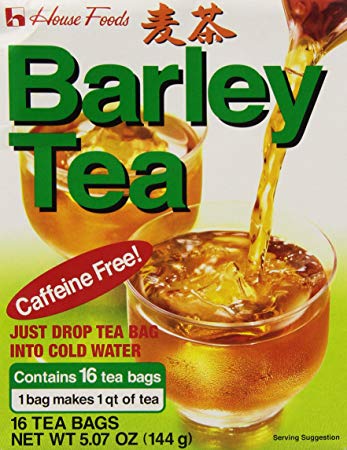
Mugicha is tea made from roasted barley and is a staple of the Japanese diet during summer. It is extremely cool and tasty, and a great way to refresh yourself during a hot summer’s day—which there are a lot of in Japan! It has a savory flavor, derived from roasting unhulled barley until it becomes the color of caramel, then steeping it in hot water. It might not be the most appetizing-looking beverage, but the taste definitely grows on you!
Virtually every Japanese person grows up drinking mugicha during the summers—from toddlers up to the elderly! My grandmother told me it’s better than drinking water because it hydrates you faster. Not sure if that’s true but when I help out in the field, that’s all we have to drink. Many people think of sake as the national drink of Japan, but mugicha probably fits that description a bit better. The most amazing thing about mugicha is that it isn’t just universally loved in Japan, but it is also quite healthy. It is free of any processed sugars and full of vitamins and antioxidants. It has been suggested that the drink helps benefit blood circulation, and that it also has cancer-preventative properties.
Another interesting thing I read on livestrong.com - According to a 2006 article in the “Journal of Agricultural and Food Chemistry,” a beverage made of roasted ground barley like mugicha, protects your teeth against cavities. It does so by preventing the bacterium Streptococcus mutans from proliferating on the tooth’s surface and causing decay. Maybe that’s why Japanese give toddlers mugicha.
I bet; you’re wondering if you can get it in Hawaii? YES, it’s sold at Nijiya Market and Don Quijote.
Brett, Manager: Lucky we Live in Hawaii!
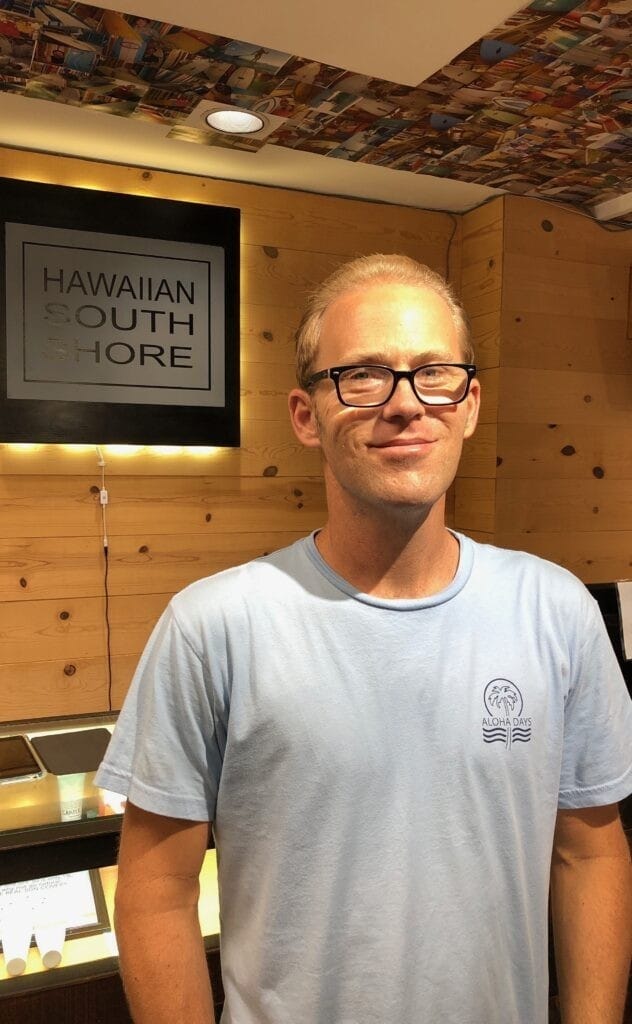
Over the past few months we’ve had a chance to get to know Brett Martin, our store manager here at Hawaiian South Shore. This month, he describes his college surf experiences and explains the differences between surfing in California and Hawaii.
So, you went straight from high school into college, right? Did you surf while you were in college?
Not as often as I wanted to, but I tried to get out once per month or so. I mostly surfed Huntington Beach and Newport Beach, because those were the closest spots to where I lived. However, it was still around a 45-minute drive when traffic was good, and more than an hour if traffic was bad.
I had my own longboard and would also borrow my friend’s shortboard from time to time. At the time, longboarding was appropriate for my abilities. The shortboard I borrowed was a high-performance 6'0", and I sometimes found it hard to catch a bunch of waves on it. But when I got out there, I always had a bunch of fun.
What were the main differences between surfing in California and surfing here in Hawaii?
The thing about surfing in California is that most days of the year, the wind is light/offshore in the morning, and then blows out by noon. So, if you can’t get out early due to your schedule, you either have to surf blown out waves or you don’t surf at all. Plus, the mornings are pretty crowded since that’s when the waves are good. You can either surf clean, crowded waves in the morning or blown out empty waves in the afternoon.
Here in Hawaii, the trades are either blowing or they aren’t, so you can basically choose where to surf based on what the waves are doing, and then surf whenever you want during the day. Since the water is so clear and warm, it’s just more enjoyable to surf. In California, the water is always cold no matter what. Both during summer and winter—it’s always cold. Also, the water is so murky, and it’s always scary because you never know what swimming around or underneath of you!
The other thing I appreciate about Hawaii is that when it rains, you can still find a lot of spots that aren’t too dirty or polluted. In California on the other hand, after it rains, you can’t really surf anywhere or you risk getting sick. Lucky, we live in Hawaii!

Boardshorts Made From Coconuts
How Vissla is Revolutionizing the Surf-wear Industry with Cocotex Technology
One of the most important movements in the surf industry over the past few years has been to find ways to produce our surf products in a more environmentally friendly manner. From eco-resins and bamboo boards to wetsuits made from plant-based rubber and sunscreens that are reef-friendly, we surfers are finally trying to clean up our carbon footprint—or at least minimize it as much as our hobby will allow.
Another way that surfers are going green is with our clothes. From t-shirts and sweaters to bikinis and boardshorts, we are finding environmentally friendly ways to make textiles from organic or recycled fabrics, thereby minimizing our impact on the earth. One of the newest fabrics is being used by Vissla to make boardshorts out of coconut fibers! Cocotex takes the unused organic waste from coconuts and turns it into a carbon fabric that dries quickly and is resistant to odors. This Cocotex is then combined with recycled “Repreve” polyester yarns to create high-performance boardshorts that are good for your skin, your surfing, and your surroundings.
While Vissla is known for their avant-garde approach to fashion and beach culture, it shouldn’t come as much of a surprise that they are also quite environmentally conscious. The brand recently signed Ph.D. scientist, Hawaiian sovereignty advocate and staunch environmentalist Clifford Kapono, who now fills an important niche on their team. As the de facto global voice of surfing environmentalism, Cliff has been the force behind the Surfer Biome Project and numerous green surfboard initiatives and competitions. Needless to say, someone as environmentally aware as Cliff isn’t going to wear boardshorts that are bad for the planet, so it is a no-brainer that Vissla would help elevate the surfwear industry and find a way to bring coconuts into the mix.
Here in Hawaii, coconuts have long been an important part of our culture and society. They provided our ancestors with food, fiber, shells for various uses, and even husks for fires. Today, they are one of the symbols of our state and people. The fact that they can also be used in the construction of boardshorts—the shorts that we wear while enjoying the pastime of Hawaiian kings—only makes them even more important.
Member of the Month: Corey Wong
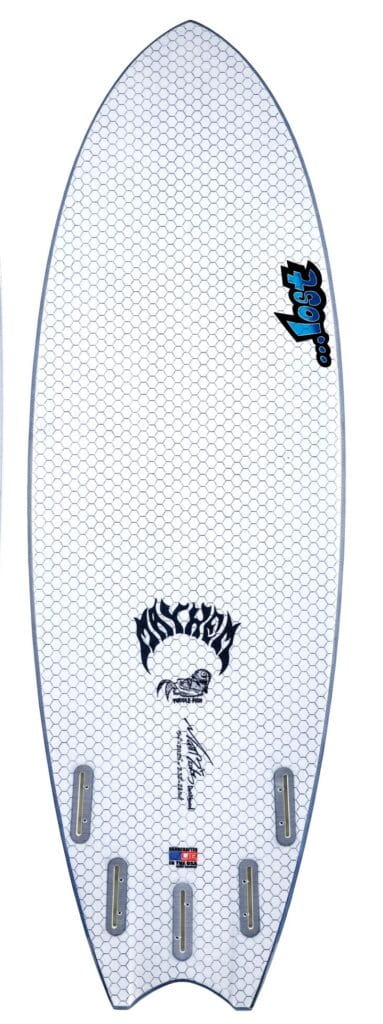
When and why did you initially get into surfing?
I started surfing around 1972. An uncle wanted me to get more physical, so he got me a surfing lesson in Waikiki. Then I got a used board and continued surfing at Queens, Pops, Threes, Concessions, Diamond Head, and Wailupe. My first new board was a Ben Aipa board. My second board was a Bonzer which I broke at Ehukai when I was trying to have my high school senior picture taken. It didn't matter; the camera broke too.
Went to college in southern California and continued surfing at Huntington Cliffs, Santa Barbara, and Malibu.
Did you have a time period you laid off from surfing? If so, when and why did you start back up?
Yes, I stopped when I graduated from college and started working as an engineer in Pasadena. I did a career change to become an acupuncturist and just focused my life on Traditional Chinese Medicine. Then I got married and moved to China for two years. We moved back to Hawaii after our first child was born. Two more eventually filled our lives. So, with work and family keeping me busy, I accepted that my surfing days were over. But when my son was sixteen in 2015, he wanted to learn how to surf. Without any surfing friends to teach him, I said I would. But first, I had to get back into it after 35 years. Started off with a 7’2”, then a 6’8”, then a 6’3”, and now I use a 5’6” board. I took my son surfing, but because he’s an engineering student at UH Manoa, he doesn’t have much time. So, I surf more than he does.
What is your favorite thing about surfing?
There are so many reasons why I like it. Most of all, I like the physical and mental challenge of surfing. Knowing I have so much more to improve keeps me going out. So with every wave I catch, I know I can do better. Then within that physical aspect, there’s peace and calmness of being in the ocean especially at sunrise (when yin energy transforms to yang energy), and having the relaxed focus of riding a wave. The people I meet out there are pretty cool too.
Where is your favorite place to eat after surfing? What is your favorite item on the menu?
Since I usually sunrise surf, I go home to eat. My Japanese wife has a Japanese breakfast prepared for me when I get home. First, she gives me a kale smoothie with fruits blended in. Then, I eat miso soup, rice, natto, and tsukemono.
What other hobbies do you have besides surfing?
Hobbies? I work seven days a week. I do acupuncture and teach various health classes. Breaking this work routine, I’ve joined Acupuncturist Without Borders and gone to Yucatan, Mexico to give free treatments to the Mayan people last year. So, other than work and surfing, my “hobby” would be taking my youngest son, Kapono, to various venues to perform playing his ukulele. Watching and listening to him play amazes me as I watch his talent grow. Now, he volunteers in the lobby of a small Waikiki boutique hotel, Vive Hotel, every Friday at 5-7pm. I have lots of fun watching his passion and talent.
How long have you been practicing and why did you choose this path?
As an acupuncturist, I’ve been nationally certified from 1985, California licensed in 1986 and Hawaii licensed in 1988. So more than 30 years I’ve been in this field. From engineering to a career in health was a decision of wanting to help people. The big question was how did I want to help people? In college, I had joined the kung fu club and whenever we got injured, our Sifu would tell us how to treat ourselves, using herbal liniments, tuina (massage), moxa, pressure (acupuncture) points, and stretching. He knew acupuncture too. So, with his encouragement, I pursued Traditional Chinese Medicine (TCM). After graduating from a TCM school in Los Angeles and getting my California license, I went to China to study more for six months. Later, after opening up my practice in Redondo Beach, I also taught at an acupuncture school until I left California in 1993. That’s when I got married and moved to China for two years, studying more acupuncture, Tai Chi and Qigong.
I know you’re teaching, could you elaborate on that?
I teach various classes including Chinese fitness, kung fu, qigong, tai chi, balance and pool exercises.
*The Chinese fitness class involves lots of stretching, strengthening, balance and is based on the kung fu warm-up exercises.
*Kung fu class includes the Chinese fitness exercises plus two-person drills, applications, and forms. It is a traditional northern style kung fu which incorporates a variety of traditional weapons.
*Qigong class is to open up one’s meridians to circulate the qi (ch’i or ki) and blood. To become more sensitive to what the body experiences, one then can feel the qi. Once one can feel it, then you can start to control it, move it, or strengthen it. Qigong is very internal.
*Tai Chi class is to learn one of the Tai Chi styles I teach. There are many styles of Tai Chi with their own characteristics. The higher level of Tai Chi is actually practicing qigong. But to get there, you learn the form first. It is commonly known as a “meditation in motion.” A Harvard study said it is “medication in motion” because of the physiological benefits that occur in the body. I say it’s all that and more. It’s also a “philosophy in motion” which refers to the yin and yang theory as applied to the body and mind.
*Balance class is usually for my patients but anyone can come. It started off to work on people’s balance but I personalize it with the exercises the person may need, to reach their physical goal whether it’s balance or something else. Usually, it’s to work on being more functional with something they cannot do.
*Pool exercise class at Rehabilitation Hospital of the Pacific. People who have some kind of physical ailment can come to this heated pool with an open ceiling. We do breathing exercises as well as exercises for strengthening, stretching, balance and agility. Sometimes, we do a Tai Chi movement in the water.
*Exercise is like nutrition. You don’t eat only one type of food. You eat a variety of food for good health. Same with exercise, you want to have a variety of exercises. Chinese fitness and kung fu are more external, more physical. Qigong is more internal, using awareness and intent of the mind. Tai Chi is both external and internal, where the physical movements can move the qi and the mind having the intent or awareness to feel it.
What's the best way to contact you if someone is interested, is it by visiting your office or attending a class?
Most new patients and students come to me through word of mouth. If you are interested in acupuncture or a tuina (medical massage) session, or in attending a class, you can contact me through phone or text at (808) 220-0934 or email me at asianhorizonsllc@gmail.com. My clinic is in the Makiki area. I have a Thursday class at Jodo Mission on Makiki St and Sunday classes outside Kuykendall Hall at UH Manoa. First class is free for you to try it out.
Tell us about the board you recently purchased from us. What model and size is it, and how do you like its performance?
The most recent board I bought from Hawaiian South Shore was a 5’6” Puddle Fish. My fin setup is the MR twin fin. I really like how easy it is to catch a wave and how it can handle small waves and holds up in the bigger ones. It is fast, loose and very responsive. I’m still working on getting it to its full potential but it makes the rider look better than he really is!
Do you have any additional comments?
I have to thank Dave and Brett for the advice they gave me in choosing my boards and fins. Since the time I started surfing in the 70’s on no leash single fin hand shaped boards, there’s been so much innovation in surfboard and fin designs. You guys have guided me to some great boards that suit me well.
NEW RELEASE IN JULY: The Slater Design's No Brainer
Kelly Slater and Dan Mann Want You to Stop Overthinking

When you are up and riding on a wave, the last thing you want to do is to start thinking about the board under your feet. Your board should be an extension of your body, something that you are so in tune with that you can completely stop focusing on it and just move instinctively. You want to be in the flow, naturally drawing on years of muscle memory and reacting to the wave as it unfolds in front of you, rather than wasting time analyzing and overthinking. What you want is a No Brainer—a board that requires no thought at all, that only needs you to surf it.
When Dan Mann and Kelly Slater designed the No Brainer, that was the goal—a board that felt so natural that you forget that it’s there. As Mann says, it’s a board that’s so easy to surf; you can shred it even if you don’t have a brain! The No Brainer blends Mann’s favorite groveler rocker with a tiny bit of extra flip in the nose and tail, to tailor the board to Slater’s surfing. The bottom contours feature a subtle belly V in the nose that gives way to a single concave under the chest. That single concave is also complemented by a double concave that runs nearly the entire length of the board, transitioning to spiral V as it exits the tail under the fins. This combination gives you forgiveness through the forward rails, drive off the tail, and all-around maneuverability.
A true groveler, the No Brainer is intended for all levels of surfers, from beginners to experts, in waves five feet and smaller on the face. It comes in sizes ranging from 5'0" to 6'6", with volume ranging from 24.6 to 49.2 liters (Slater’s personal No Brainer is a 5'4" with 27.0 liters). Utilizing Firewire and Slater Design’s Linear Flex Technology and a five-fin box setup, the No Brainer is lightweight, reliable, progressive, and versatile—the perfect summer board.
The Making of the Waimea Bay River Break
Most of us here in Hawaii have seen footage of the standing wave at Waimea Bay, which forms when the river flows out of Waimea Valley and breaks through the beach.
Have you ever wondered when and how that standing wave forms, or how long it lasts?
We did some research into the formation of the “Waimea River Break,” and what we found out was actually pretty unsurprising.
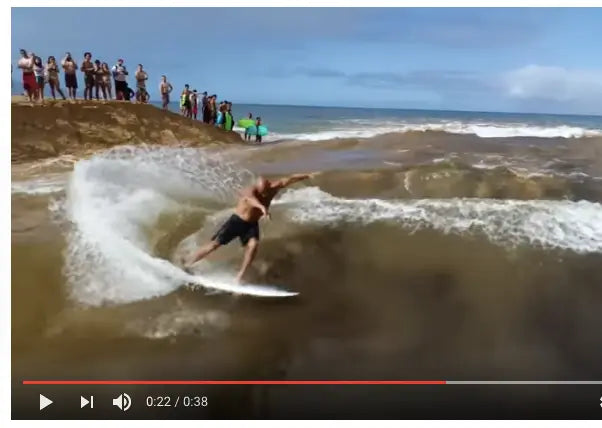
First of all, Waimea Bay is one of the biggest waves on the North Shore—this isn’t really news to anyone. Over the summer and winter, sand gets moved around the North Shore by currents and waves (again, not exactly revelatory news), and since Waimea Bay has some of the biggest waves and strongest currents on the coast, it is no surprise that sand builds up on the beach, making it a great place for people to enjoy the sun, watch people charge huge waves in the winter, and jump off the famous Waimea Jump Rock during the summer.
Most of us also realize that winter can be a bit rainy on Oahu—just think back to February and March of this year! When the rain really gets going, Waimea River starts to flow out of the valley, but with all the sand that gets built up on the beach, the river isn’t able to empty into the bay, which is its natural endpoint. The water eventually starts to backfill the valley and the marsh behind Waimea Bay beach, which actually isn’t great for the local environment, since the river naturally wants to empty into the ocean.
Left to its own devices, the river will typically either break through on its own, or eventually dissipate as the winter rains come to an end. But with so many miscreants (aka: surfers) living on the North Shore, it’s been years since the river has been left to its own devices! Once the water gets close to breaking over the sand berm, a bunch of locals takes matters into their own hands. They dig out a trench through the berm, connect the trench to the backed up water, and within a few hours, the flowing river has torn open the beach and emptied its guts into Waimea Bay. And in the meantime, it creates a pretty fun (if not short-lived) standing wave.
The legality of digging out the river is questionable, but at the end of the day, no one really complains. After all, no one is doing anything that nature doesn’t do on its own—they are just speeding up the process so that it happens during daylight hours, when the wave can be enjoyed by everyone. (That being said, the river does usually tend to get dugout in the evening, once the authorities
Next time you see a long period of rain followed by a major flat spell on the North Shore, head on over to Waimea Bay, and you just might ride the longest wave of your life!
Reviews and Who's Stopped By
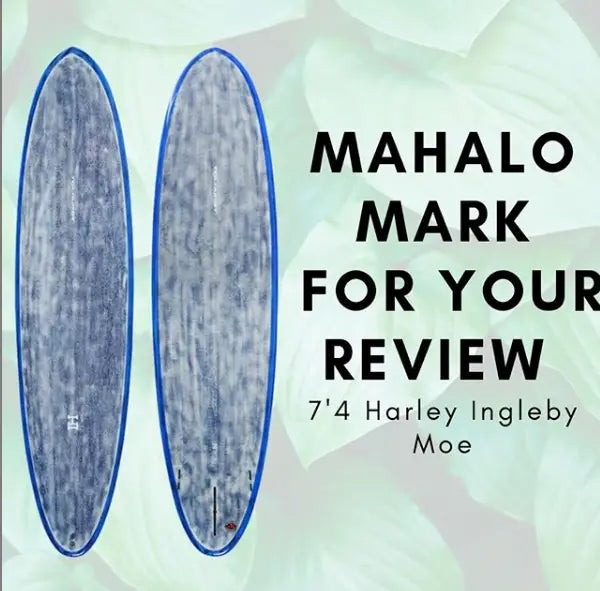
"Moving from a 7'2 Funboard to the Harley Ingleby Moe with a thruster setup has been an exciting step up to more progressive surfing. Friends in the lineup have told me to leave the other board home as this board has proven to improve my ability to turn, add some cutbacks, and gain some speed to my surfing. As someone that qualifies for social security, those are all huge pluses. Mahalo for the excellent advice. - Mark" ⠀
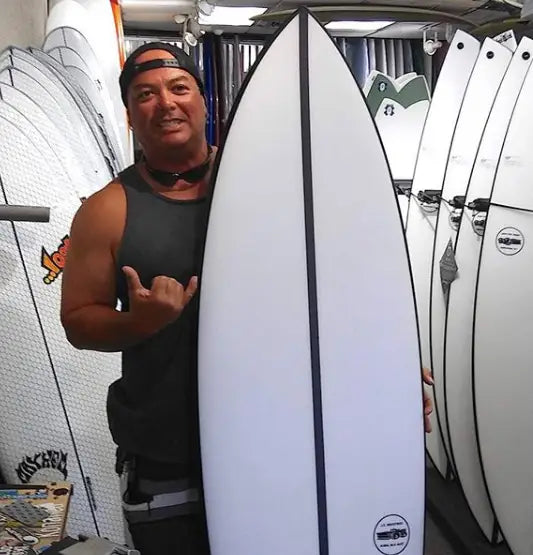
Our Long time VIP customer Gabe picked up a JS Black Baron…we’ve been selling many of these. I have one and after letting 5 people try after one ride, they are blown away at how the board feels. - David
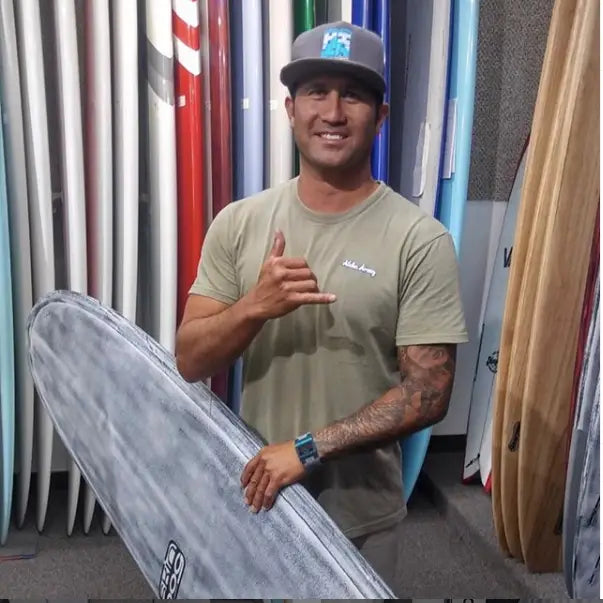
Local Pro Kapono Nahina stopped by and picked up a Ben Skinner
